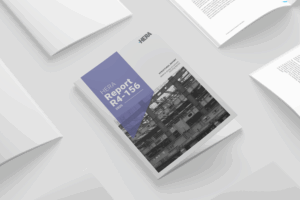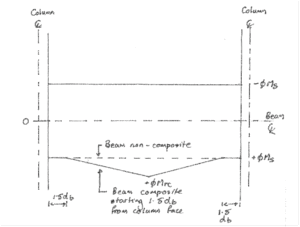New Zealand’s seismic risk profile is among the highest in the world. As events like the Canterbury and Kaikōura earthquakes have demonstrated, moment-resisting frames play a critical role in resisting seismic loads and maintaining building stability during seismic events

In a nation shaped by seismic activity, ensuring the integrity of our built environment is not just good practice — it is a matter of public safety and building resilience.
With this imperative in mind, the Heavy Engineering Research Association (HERA) released in March an update to its seismic steel design guidance, refining the design of moment-resisting steel frames for enhanced performance in earthquakes.
The revised HERA report R4-156, Seismic Design of Moment-Resisting Steel Frames represents a crucial advancement in structural engineering practice in New Zealand.
The update integrates the latest international research and detailing practices, offering practical insights and worked examples for engineers navigating the complexities of seismic design.
In doing so, it underscores HERA’s commitment to providing the country’s construction sector and engineering industry with tools that are evidence-based and tailored to local needs.
Why it matters now
The updated R4-156 design guide comes at a time when demand is growing for greater resilience in our infrastructure, and when design professionals are grappling with increasingly complex regulatory and performance requirements.
It also coincides with the Government’s renewed focus on improving the seismic resilience of public buildings and critical infrastructure, reflected in initiatives such as the National Seismic Hazard Model update and proposed changes to the Building Code.
These structures are often used in low- to mid- rise commercial and institutional buildings and must meet stringent performance standards to ensure both life safety and asset protection.
The guide bridges the gap between theory and implementation, helping engineers apply seismic design principles more effectively in real-world scenarios while supporting national goals to future-proof infrastructure and reduce risk exposure.
Key improvements
The 2025 edition of R4-156 is a complete rework of the 1999 version. It includes:
- revised guidance for seismic loading and design philosophies — aligned with NZS 1170.5 and considering lessons learned from recent international seismic events
- improved connection detailing examples -detailed worked examples demonstrate how to design and detail moment connections to achieve ductility, energy dissipation and robustness
- clarified technical commentary: enhanced explanatory text provides clearer context for key design decisions, making the guide more accessible to both junior and experienced engineers
- Updated international research integration: incorporates examples of global best practices, including developments from the US, Japan and Europe, adapted for local relevance.
These changes enhance the document’s usability, making it a go-to resource for engineering practitioners engaged in seismic design.
Local application and Industry impact
The guide is especially relevant for engineers working on buildings in high seismic risk zones such as Wellington, Christchurch, and the East Cape.
Its publication has already triggered interest among consulting engineers, contractors, and developers seeking to future-proof their projects.
“This update reflects our ongoing investment in the seismic resilience of New Zealand’s infrastructure,” says HERA chief executive Dr Troy Coyle.
“It’s also part of a wider strategic focus on building capability in steel design and encouraging uptake of best-practice engineering.”
For firms involved in structural design, the guide offers practical clarity in an area where misunderstanding or misapplication can have serious consequences.
For those newer to the field, it provides a reliable educational reference, while more seasoned engineers will find it a valuable check against evolving best practices.
Building performance, Safety & sustainability
The revised guide also contributes to wider conversations about the sustainability and longevity of New Zealand’s built environment.
By improving the seismic performance of steel frame systems, buildings can better withstand seismic events without needing major repairs or demolition; a key principle of sustainable design.
Steel’s inherent recyclability and durability make it a strong candidate for sustainable construction when combined with thoughtful seismic detailing. R4-156, therefore, complements other emerging efforts to reduce whole-of-life carbon impacts and improve the circularity of building materials.
As governments around the world explore new pathways to reduce carbon emissions and climate risks through construction reform, tools like R4-156 help ensure resilience and sustainability are addressed in tandem.
Cross-sector collaboration
HERA is actively encouraging feedback and case study input from engineers, contractors, and regulators applying the guide in real-world projects. This participatory approach will help ensure future iterations remain dynamic and responsive to industry needs.
Collaboration is particularly important as New Zealand works to modernise its building code and align more closely with performance-based approaches seen in international jurisdictions.
A shared understanding of how moment-resisting frames perform, and how to design them well, will help regulators, clients and designers deliver safer and more efficient buildings.
The updated guide can also assist local and central government agencies in implementing resilience-focused procurement strategies and achieving consistency across regulatory systems.
Looking ahead
While the seismic risks facing New Zealand will never fully disappear, the tools to mitigate them are becoming more sophisticated. The 2025 revision of HERA R4-156 is a timely and valuable addition to the engineering toolkit, equipping professionals with clearer, more actionable guidance for designing resilient steel structures.
It also reaffirms HERA’s role as a thought leader in advancing structural design practices that protect lives, support sustainable development, and drive innovation across the sector.
As the country continues to rebuild and expand, particularly in urban centres with high seismic risk, the need for informed and thoughtful seismic design remains paramount.
This updated guide will help ensure that the buildings we inhabit tomorrow are stronger, safer, and more future-ready than ever before. For more information or to access the updated R4-156 guide, visit www.hera.org.nz.
 Dr Troy Coyle brings more than 20 years’ experience in innovation management across a range of industries including materials science, medical radiation physics, biotechnology, sustainable building products, renewable energy, and steel.
Dr Troy Coyle brings more than 20 years’ experience in innovation management across a range of industries including materials science, medical radiation physics, biotechnology, sustainable building products, renewable energy, and steel.
She is a scientist with a PhD (University of NSW) and CEO of HERA.





